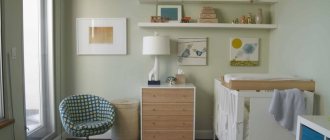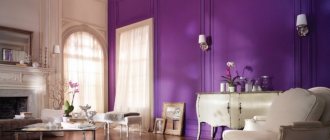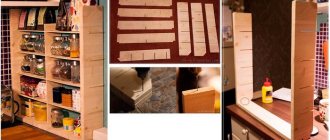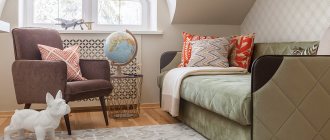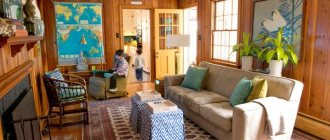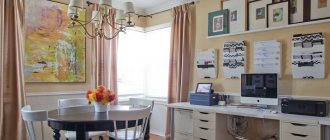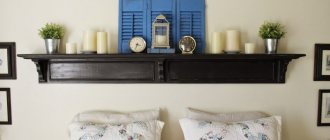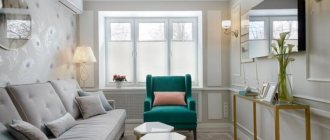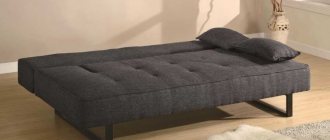Wall shelves help solve the problem of placing small items that are often stored in cabinets and boxes. It is very difficult to find chaotically folded books, souvenirs and other useful things in everyday life. The wall design allows you to arrange them in a certain order, so that the right thing is always at hand. In addition, a small piece of furniture can be used to support the concept of the style chosen for the interior.
The combination of aesthetic qualities and functionality is highly valued by designers, so they often use this technique in developing the furnishings of a room. Making shelves for the wall with your own hands from wood is not at all difficult; you just need to choose the appropriate configuration and follow the clear instructions of specialists.
Design features of shelves
The main advantages of a homemade shelf are its ideal parameters and support for architectural lines visible in the interior. You can, of course, purchase a ready-made product, but if you have minimal experience in using carpentry tools, making a shelf yourself is much more pleasant. And the chosen piece of furniture in the store does not always match the color scheme of the room. It’s even worse if the dimensions of the items planned for storage do not fit in the equipped niche.
Work on assembling the shelf should begin with a drawing. In order to competently develop a project, you need to determine what type of structure the structure will be.
• The open model has only a working surface. There are no walls or doors.
• The closed shelf resembles a miniature cabinet with a hanging method of installation on the wall. This option is equipped with identical structural elements: doors, rear and side walls, possibly with an internal partition.
• Corner structures are placed in the corners of the room at a comfortable height. Moreover, models are developed separately for internal and external corners.
• Asymmetry – a design of several shelves placed without reference to the center line. Such models are not devoid of functionality, and from an aesthetic point of view they are original.
• Hanging shelves are not fixed to the wall; they are held in place by plaits, cables, belts, fixed to the ceiling using hooks or dowels.
• Decorative models are designed more to maintain the style of the interior. Small souvenirs or photo frames with family photos are stored on beautifully decorated shelves. Also, such options are used by collectors to place items of pride.
What types of shelves are there?
Shelves are not only almost the main place for storing various household items, collections or highlighting design. They themselves complement the design and are a reliable and spacious storage for essential items.
Fantasy has no political boundaries
One of the outdated definitions says that a shelf is a horizontal board attached to a wall, mounted in it or in a cabinet, used for storing household items (books, souvenirs or dishes). Not everything is as simple now as it once was. Shelves are not always horizontal, not necessarily attached or built-in, and not even wooden boards at all.
Based on their location, shelves are divided into three main categories:
- wall shelf
- corner shelf
- hanging shelf
Based on the main materials, shelves are divided into:
- MDF, chipboard shelves
- gypsum fiber shelves
- wooden
- metal
- glass
- plastic
- combined (at least two materials)
It is important to understand that this list is not dogma. If you have a developed imagination, you can make a shelf from an egg patch or a cardboard box. In this case, neither functionality nor an appropriate design solution will be lost.
Based on their design, shelves are divided into:
- console
- with back wall
- with side walls, one wall, without them
- horizontal
- vertical
- multi-tiered
- with sliding door
- straight, inclined, radius
Material selection
Wood is considered the most convenient material to install and maintain, taking into account its absolute safety for the health of household members. From the existing wide range of wood for the manufacture of shelves, the following are used:
• plywood;
• natural massif;
• edged board;
• regular and laminated chipboard sheets;
• MDF.
Even thick branches, saw cuts, and logs can be used to create original structures. If there are bars, slats, or planks left on the farm after construction, they can also be used in the work of assembling shelves.
To add zest to a product, it is worth complementing it with decorative or functional elements made of carvings, glass, wrought iron or a fragment of natural stone that has an interesting shape.
Reference! Recommended shelf parameters: material thickness – 25 mm, width – up to 200 mm.
Bathroom
It’s hard to imagine a bathroom interior without a corner shelf on the wall. This is the optimal solution for storing a large number of cosmetics. It is inconvenient to place jars and tubes in cabinets that should always be at hand.
There are two main manufacturing options - glass combined with a chrome stand or plastic with a metal stand. There is not such a variety of models as in the kitchen and hallway for the bathroom. The laconic design is caused by special operating conditions. Regular contact with water or simply high humidity provokes rapid contamination of the surface. It is the simple outlines that will help you keep the corner shelf on the wall clean and not spend a lot of time on maintenance.
Advice! It is not advisable to make a shelf on the bathroom wall with your own hands.
Manufacturers offer a wide range of functional ready-made specimens, which are equipped with all kinds of hooks for washcloths, special soap dishes and have perforations for water drainage.
Cutting out the parts
Shelf parameters are determined based on individual preferences. The drawing is taken as a basis. It is better to make it in several copies with a review of different sides.
Cut wood parts with a jigsaw. If you don't have a tool, you can use a hand or circular saw.
Reference! The quality of the cut is better after sawing wooden parts with a jigsaw.
When making blanks for corner structures, the ends of horizontally located planks are beveled. Their joining should follow the shape of the corner of the wall where it is planned to fix the structure.
When purchasing wood, it is important to correlate its dimensions with the parameters of the shelves. This will avoid overspending. If used material is used, you should first inspect it for defects. It is better not to take such fragments into work.
There will be no problems with cutting wooden boards, but you will have to tinker with chipboards. Alternatively, contact a carpentry shop. To do the work yourself, you need to take into account the following recommendations from experienced craftsmen.
• A spacious room is allocated for cutting wood panels. You can use the garage.
• The cutting table must have stable legs.
• Clamps are used as fasteners.
• The cut is made with a jigsaw or a circular saw.
• First, the pattern is transferred to the sheet, the markings are made with an alcohol marker or a simple pencil.
Reference! Experts advise sticking masking tape to the edge of the marking, then the saw will more accurately repeat the configuration of the part.
Design features and methods of fastening
There are many ways to design corner structures on the wall. The most common models are designed for internal corners.
Comment! A design with an external corner requires an individual approach to the manufacture of shelves. This option is appropriate in spacious rooms.
Corner wall mounted shelves amaze with their variety of designs. Simplicity and conciseness are inherent in specimens where one or several small shelves with a rounded edge occupy only a corner. Models that spread out to the sides along the walls look much more interesting. They can be symmetrical or of different sizes, complemented by side walls or remain minimalist. An example of corner shelves on the wall in the photo:
In addition to wall structures, there are other practical ways to decorate the interior. A corner shelving unit with open shelves is a functional solution for storing a large number of books or things.
There are multi-tiered models of whatnot type. You are unlikely to achieve space savings with such an interior element, but there is an exclusive design.
The method of wall mounting is chosen taking into account the design of the corner shelf. Small single-level models are fixed with hinges; metal corners are suitable for multi-tiered products. Brackets are used when attaching shelves intended for heavy objects to the wall. Glass shelves on forged stands look nontrivial. Hidden fastenings will add glamor to the interior, making the shelf seem to float in the air.
Creative individuals who value a non-standard approach to solving common problems will like ideas where belts or chains supplemented with anchor bolts are used to fix shelves to the wall.
How to process workpieces
When all the parts are cut out, you need to process the blanks.
• When using solid wood or planks, carefully sand the edges and surfaces with a sander. If there is none, you can get by with fine sandpaper. Finished parts are thoroughly cleaned of dust and pods and soaked in an antiseptic solution. Once the surface is dry, apply a layer of primer. The final finishing is performed after the structure is completely assembled.
• If chipboard or MDF sheets are chosen as the base, then after cutting there is a need to glue the ends. Leaving the cut open is prohibited due to the evaporation of formaldehyde resins that are used to press sawdust and pieces of wood. The process of gluing the edge involves applying wood glue to the end of the workpiece, followed by fixing a thin tape (its thickness corresponds to the parameters of the ends of the parts). To create a reliable fixation, the work is performed using high temperatures. This can be done at home using a heated iron.
DIY shelf ideas and options with photos
Before proceeding directly to the manufacture of the shelf, it is necessary to draw up a preliminary drawing. For a do-it-yourself shelf diagram, draw its shape on a sheet of paper and apply the dimensions. Based on their design, shelves can be divided into two main types.
The first type includes hanging shelves, which are attached to the wall due to their own weight using special holders. They can also be attached to vertical supporting racks made of boards, bars or pipes (like shelves in a closet). This type of shelves is good if there are no excessive demands on them in terms of strength. They are also the easiest to manufacture, since the crossbars for them and the holders do not need to be connected to each other. Hanging shelves are good for saving material. The holders can be attached directly to the wall. After this, one crossbar is placed on top - and the shelf is ready. The linear size of the protrusion must be at least 3/4 of its width to avoid tipping over.
The second type of DIY shelf at home is more durable, because... In this case, holders are not required, since it is a monolithic finished thing. It can be removed and hung in another place, placed on a table or bedside table, or turned over. This will not change its properties. They are more often used where a large number of vertical compartments are required. For example, for filing cabinets or catalogs. Usually you have to combine these two types. You can make a large, durable shelf and add hanging ones. Or, conversely, put several portable ones on a large canopy.
Look at the photo of do-it-yourself shelf options, which illustrate a variety of design ideas:
Assembly procedure
The assembly order depends on the design of the shelf. If a closed model is being made, then first assemble the frame with the back wall, after which the body is attached to the wall. Doors and fittings are already installed on site.
If an open shelf is mounted, then assembly begins by connecting the sides to the upper and lower walls. The following elements are used as fastening:
• dowels;
• metal corners;
• self-tapping screws;
• eccentric coupler;
• screws, etc.
Before screwing in the hardware, you need to drill a hole. In some cases, it is enough to get by with an awl, but craftsmen more often use a drill and a bit of slightly smaller diameter than the hardware used.
Reference! When marking a hole along the edges, you need to make an indent of at least 4-5 cm.
Dowels provide reliable fastening if a large load is not planned on the shelf. The connection will be even stronger if you place the dowel on wood glue. After pressing the parts, excess adhesive is immediately removed with a damp cloth.
Corner wooden shelves
Often, to save space, shelves are made corner, and they can be mounted both in the inner and outer corners.
Corner shelf
Corner wooden shelves
The blanks are made according to the scheme described above, only the upper and lower boards consist of two elements, with the ends cut at an angle. The process of making such a shelf is quite simple:
- the halves of the top board are coated at the ends with glue and clamped with clamps;
- repeat the same actions with the bottom board;
- when the glue dries, all workpieces are covered with stain or primed;
- Attachment lines are marked on the upper and lower workpieces and holes are drilled;
- insert the side walls and secure them with self-tapping screws.
Next, screw the brackets and secure the shelf to adjacent walls.
Corner shelf made of wood
| Wall shelf materials | Advantages and disadvantages |
| Wood: plywood, chipboard, MDF and others | This material is relatively easy to work with, it looks beautiful, natural and impressive, its service life is quite long, especially if pre-processed |
| Plastic | This material is the most versatile; it can imitate both wood and stone, while eliminating their shortcomings |
| Metal | Such wall shelves will be very strong, reliable and durable, but they will hardly fit into a classic interior. In addition, corrosion can also be a problem, so metal products will require special processing and conditions |
| Glass | Transparent wall shelves will create an atmosphere of lightness and comfort in your home. Of course, it will be quite difficult to make a glass structure with your own hands, but if you nevertheless decide to do all the work yourself, then you will have to work with glass for quite a long time and very carefully, especially if various cutouts are planned in the shelf design |
Mounting a shelf on a wall
This is perhaps the most crucial stage. Before attaching the structure to the wall, it must be treated with paint, varnish or other finishing material. As soon as the shelf is dry, begin installation.
The simplest option for hanging a structure on a wall involves using a hanging corner. This method is called classic. The upper eyelet is pre-fixed with a suitable dowel, the lower one is attached to the shelf with a bolt (plus a nut and washer) or a self-tapping screw.
If the planned load on the shelf is determined by the parameters 20-50 kg, it is more rational to use special brackets.
Important! Before making holes in the wall, it is recommended to double-check the horizontal and vertical marks with a building level.
The most durable fastening is considered to be an anchor bolt. It is recommended to select anchors with the following parameters:
• length 18 cm;
• diameter 1.2 cm.
The bolt itself must have a thread, thanks to which the wooden surface of the shelf and the metal coupling (placed on the other side of the anchor) are screwed in.
In addition to the classic installation method, hidden fastening is used. This option is used in cases where the decor is not compatible with protruding fasteners and hardware. The essence of the technology is to make holes in the end side of the shelf into which protruding elements, fixed to the wall, fit.
Hanging shelf with straps
If you need a decorative shelf for small items, the following option is perfect - a board suspended on straps.
Hanging shelf with straps
Hanging shelf
To make a shelf you will need:
- 2 edged boards 300x750 mm, 30 mm thick;
- 4 leather belts, 75 cm long;
- 4 long screws with plastic dowels;
- 4 short screws;
- building level;
- ruler;
- sharp knife;
- drill.
Step 1: Preparing the belts
The cuts of the belts must be perfectly even, so if necessary they are trimmed with a knife. Fold each belt in half, press the ends to the table, step back 2 cm from the edge and drill a neat through hole with a drill. The same is done with the remaining three.
Step 2. Attaching the straps to the wall
Using a level, two points are determined on the wall at a distance of 60 cm. Holes are drilled and plastic dowels are inserted. The belt folded in half is applied to one of the holes and secured with a long screw - you get a large loop on the wall. Another such loop is attached nearby.
Step 3. Installing the shelf
A sanded board is inserted into the loops and aligned horizontally. To prevent the shelf from moving, the parts of the belts adjacent to the wall near the board itself are screwed with short self-tapping screws. Now another shelf is hung under this shelf, exactly repeating the steps described above. The result is a light and neat two-tier shelf. If desired, you can add another 1-2 tiers.
To make the shelves described above, you can use not only wood, but also plywood, as well as laminated chipboard sheets. The last option is used most often, since laminated chipboard is lightweight, high strength, practicality and durability. When assembling shelves from this material, all sections must be covered with a melamine edge to match the color of the sheet.
Hinged shelf with straps
Hanging shelf
Hanging shelf with straps
Decoration
If, after attaching it to the wall, the structure looks faded and boring, you can add a little decor. To make shelves filled with various objects aesthetically pleasing, it is recommended to take into account the advice of experts.
- Ideally, the color of the shelf should contrast with the contents. You should adhere to the rule that only one key dominates.
- You can avoid chaos on your shelves with the help of triads. To do this, items are placed on multi-level shelves in such a way that the chosen expressive color creates the appearance of an imaginary triangle. The remaining tones are built according to the same principle.
- Place large objects at large intervals from each other so as not to make the structure bulky and sloppy.
- Small objects look impressive against the background of paintings and photos installed in a frame. With large vases and sculptures they are almost lost.
- It is recommended to place objects similar in parameters and color relative to the axis of symmetry (vertically and horizontally).
- Heavier contents should be placed on the lower tier, while the upper tier is reserved for lighter luggage.
- The arrangement on the shelves should be done according to a thematic principle. Then it will be more interesting to look at the contents of the shelves.
Reference! Bouquets of branches, beautifully shaped driftwood, balls of rattan and other interior decorations are ideal for decorating shelves.
Shelves in the living room in a modern style
An interesting composition can be created from wall shelves, especially if they have unusual shapes. In the last few seasons, house and honeycomb shapes have been particularly fashionable. They can be freely grouped and placed on walls, bringing a new aesthetic quality to a modern room.
Next to simple hanging shelves made from various materials, you will find a wide range of very complex models, for example, in the shape of tree branches, zigzags. It is worth choosing this type of shelves when you want them to be the main accent in the room.
Honeycomb shelves
Prefabricated structure, including individual hexagonal cells. This original idea is suitable for rooms for different purposes, be it a nursery or a kitchen. You will have to put in some effort to complete the installation, but the result will pay off with rave reviews from family and guests at home.
You need to start work by cutting the board, which is divided into 15 parts 30 cm long. To create a honeycomb, the sides are cut at an angle of 30°. After processing the blanks with impregnation and varnish or decorative coating, they begin to assemble the first cell. The glued hexagonal section is reinforced at the corners with self-tapping screws. The remaining cells are assembled in a similar way, complementing the existing assembly. In this way, the planned number of sections is connected. If desired, you can install an additional shelf in the cell itself.
Reference! Cells can be assembled on the basis of a module, where adjacent sections have a common wall, or represent separate segments connected to each other by dowels or other hidden means.
When screwing in self-tapping screws, cracks often form on the parts. To avoid damage to the material, it is recommended to first make a hole with a drill (diameter 1-1.2 mm).
Living room
Shelves on the living room wall are an indispensable piece of furniture. The range of their use is very wide. Reading lovers will benefit from a spacious corner shelving unit with open shelves. Wall shelves, the size and configuration of which are selected taking into account their purpose, will save free space. A large number of books requires the installation of a three-dimensional structure on the wall. In this case, the reliability of the fastening deserves attention. If a functional piece of furniture serves as a stand for decorative elements, opt for more compact models.
Often icons are placed on small corner shelves. Particularly exquisite are the pieces with carvings and figured wooden details.
Wall-mounted models designed for indoor plants are no less popular. Depending on the situation, choose elegant metal or wooden products.
Corner glass shelves are less common in the living room interior; they are mainly intended for displaying small souvenirs, photo frames and figurines. To maintain an atmosphere of lightness in the interior, you should not place a large number of things on an open corner shelf, so as not to create the effect of disorder or clutter.
Plasterboard structures on the outer corners of walls look extremely aesthetically pleasing. Owners of spacious interiors can afford such luxury. For compact housing, it is important to use LED lighting, which will become an inexpensive and attractive design element.
Shelf module
This model consists of 4 elements: 2 sides, top and bottom. The parts are connected with self-tapping screws or other fasteners. Several modules of different sizes and colors add special notes to the design of the room. Separate cells are filled with things of similar themes.
To make the structure, you will need a shaped board (it is better to take pine). The following parameters are suitable: thickness 16-20 mm, width 15-18 cm. In addition to the board, sheets of chipboard, MDF, laminated chipboard, plywood are suitable. Fasteners are selected individually (screws, metal corners and other furniture fittings).
The technology for assembling the structure is considered the simplest. The work is performed in the following sequence:
- cutting parts;
- wood processing, edge gluing;
- making holes for fastening;
- connection of the sidewalls with the transverse parts of the structure;
- applying the finishing coating;
- attaching the module to the selected location in the room.
This model is equipped with partitions and other functional decor.
Wall shelves in the living room
Today you can find a wide selection of shelves, which are found in both classic, simple and modern and unusual forms, so they will not only be a place to display your decorations, but a self-contained decor. An interesting piece of furniture is the round hanging metal shelf, which will add unusual character to any room. A shelf with baskets is also considered an original solution. If you want to highlight things that are important to you in a special way, you should choose a shelf with LED lighting. Glass and metal objects will look especially good. If you want to use the living room in the most functional way, a corner shelf will be an excellent option, thanks to which you will save a lot of space.
If you're wondering what to put on your living room shelf, there are plenty of options. In addition to the books and DVDs already mentioned, shelves are a great place to display photos of family and friends in decorative frames. On the shelves you will also place plants in pots or stylish vases, as well as scented candles, lanterns and other decorative elements. In fact, any item that you consider worthy of display will be suitable for placement on the shelves.
Shelf with hidden fasteners
If you want to give the structure some airiness, it is recommended to make it with hidden fasteners. A timber with a well-polished surface is prepared for work. Its thickness should be in the range of 2.5-3.0 cm. You will also need a board (the thickness indicator is chosen identical to the timber). Pine is ideal for installation due to its flexibility of processing and affordable price.
Reference! To install shelves with hidden fastenings, dowels, wood glue, screws and dowels are used.
The manufacturing process includes the following steps:
- cutting of material (timber and board are cut to a given size);
- holes are made from the side of the block and the board at an equal distance from the edges so that they coincide at the junction (the depth of the holes corresponds to the length of the pins);
- securing the timber to the wall (using self-tapping screws and dowels);
- pins coated with adhesive are inserted into the holes made in the timber;
- the surfaces of the parts are coated with glue in the area of their connection;
- installation of a shelf with mounting on dowels (the parts are pressed tightly and fixed).
To control, the board is tapped again with a mallet to ensure a tight fit on the pins.
Regardless of the type of model, making a shelf on the wall with your own hands from wood is considered a feasible task. With a creative approach to business, you can bring functionality and freshness to the interior for little money.
Photo gallery of ideas
If none of the methods we suggested for making a shelf appeal to you, we suggest looking for ideas in our photo gallery. Here we have collected other examples of wall shelves that you can make with your own hands from wooden boards, the same pallets, boxes and other readily available “lumber”.
Corner shelves
Making your own corner shelf couldn't be easier. To make one shelf as in the photo below, cut out a triangular blank of the desired size and with the required angle (rarely the internal corners of the walls are exactly 90 degrees) from plywood or wood 1.5-2.5 cm thick, as well as two small support strips (length one strip should correspond to the leg of the triangular workpiece, and the length of the second strip should be calculated according to the formula: length of the leg minus the width of the first strip).
DIY corner shelf
All parts need to be thoroughly sanded and then painted or simply treated with wax/varnish. Next, make markings using a building level both on the walls and on the planks (note that the holes will be through!). Drill holes in the walls, insert dowels into them, and then hang the supports using screws using the through-hole method. It is important to choose the correct screw length - it should be calculated using the formula: dowel length + thickness of the support bar + screw diameter. Finally, all you have to do is install the shelves and secure them either with wood glue or wood nails/screws. If you want to hide the heads of the screws, use wood putty, and then paint over the “patches” with paint to match the shelf.
You can screw hooks for mugs into the bottom of the kitchen corner shelf
DIY Corner Bathroom Shelf
Homemade corner shelves of different sizes
Skateboard shoe racks
To make a shelf out of a skateboard, you need to remove the wheels from it and then hang it on the wall using brackets.
Shelf in a baguette
A shelf framed by a frame is easy to make: first you need to put together a frame of boards according to the size of the frame, then you need to install several divider strips inside the box.
Shelf with flywheel hooks
If you have a simple wooden bathroom shelf, decorate it with cross ceramic faucet handles. It’s hard to imagine a more stylish thing!
Wall storage system
Boxes are almost ready-made shelves that you just need to hang on the wall.
From several single type drawers you can make a full-fledged modular storage system.
Hanging shelves made of wooden boards and leather straps
From a wooden board and a couple of leather straps, you can make just such a stylish hanging shelf with your own hands.
Shelf for storing fruits and vegetables
As you know, some fruits and vegetables need to be stored at room temperature. But where can we find a place for this? Our answer is on the wall using a shelf like this made of wooden boards and metal baskets.
Corner shelf options
Finding a practical use for any shelves is not at all difficult, because in every home there are things that need to be organized. The area of the room does not always allow for a sufficient number of storage systems. In a small apartment, every centimeter of space is valuable and the owners try to make all corners of their home as functional as possible. Light and at the same time spacious corner shelves will help not to overload the room.
The attractiveness of corner shelves depends on the chosen material, the originality of the design and additional accessories.
For books
A corner shelf as a book storage rack is not very convenient, but it is a pretty good option for a small room in which it is difficult to place a full-fledged bookcase. A small corner library will be good for a child’s room, since a child usually does not have as many books as in the parent’s bookcase.
The dimensions of the corner shelf should correspond to what will be stored on it
It is advisable to store books in closed cabinets so that they do not become covered with dust, otherwise you will have to vacuum your library quite often.
For storing accessories
If the shelf is used for accessories, the sole purpose of which is to decorate the interior, then on each of its compartments it is better to place either one independent decorative item or several, complementary and made in the same style. These can be figurines, vases, candles, photographs in frames, flower pots.
You can make a neat shelf for accessories with your own hands from plywood.
And others
In the kitchen, an open corner shelving unit can be used to place tea and coffee utensils in beautiful ceramic or tin cans, containers with spices and other frequently used kitchen utensils.
Wooden shelves fit perfectly into the kitchen interior, made in Scandinavian, Provence or country style
In the children's room, your favorite toys will be conveniently placed on a shelf in the corner. It’s good if one of the compartments is closed - it’s convenient for a girl to store hairpins, rubber bands, bows, and for a boy - small toys, various collections that often create a mess in the room, but children really love to collect them.
Plastic corner shelves with sides in a child's room
In a nursery, for safety reasons, it is not advisable to use a hanging rack for toys or books; a child may inadvertently tear off the shelf and be injured. For reliable stability, it is better to additionally attach a rack standing on the floor to the wall, then no matter what games the children come up with, they will not be able to knock over the furniture on themselves.

